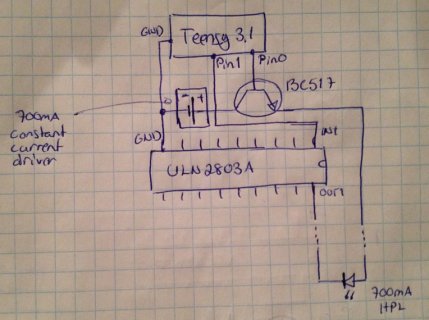JarkkoL
Well-known member
Hi,
I'm trying to implement 3W HPL matrix (3x8) controlled with Teensy. I'm using ULN2803 to sink the power from HPL catodes in 8 rows which I believe works fine, but the problem is providing power to the 3 anode columns. I build a circuitry with BC517 NPN transistors for this, but for some reason the transistors don't get saturated (LED is very dim). I believe this is because in the circuitry the emitter is connected via HPL & ULN2803 to ground, but I'm not quite sure. Here is the schematic of the controller:

Should I use PNP transistors instead to avoid the control current from Pin 0 going through the HPL? I'm newbie with the electronics so spare with me and anything obviously stupid I'm doing
Thanks, Jarkko
I'm trying to implement 3W HPL matrix (3x8) controlled with Teensy. I'm using ULN2803 to sink the power from HPL catodes in 8 rows which I believe works fine, but the problem is providing power to the 3 anode columns. I build a circuitry with BC517 NPN transistors for this, but for some reason the transistors don't get saturated (LED is very dim). I believe this is because in the circuitry the emitter is connected via HPL & ULN2803 to ground, but I'm not quite sure. Here is the schematic of the controller:

Should I use PNP transistors instead to avoid the control current from Pin 0 going through the HPL? I'm newbie with the electronics so spare with me and anything obviously stupid I'm doing
Thanks, Jarkko

